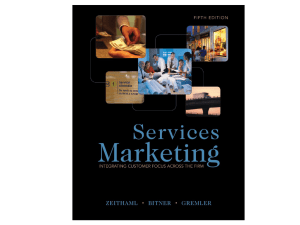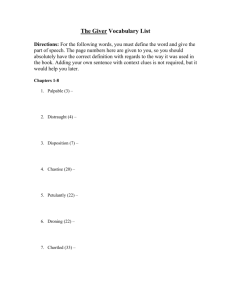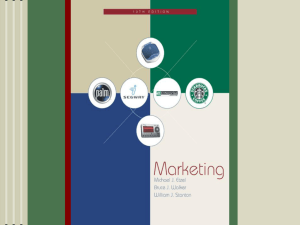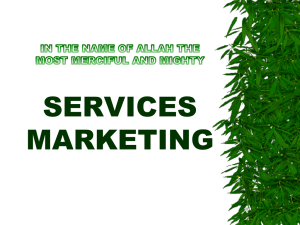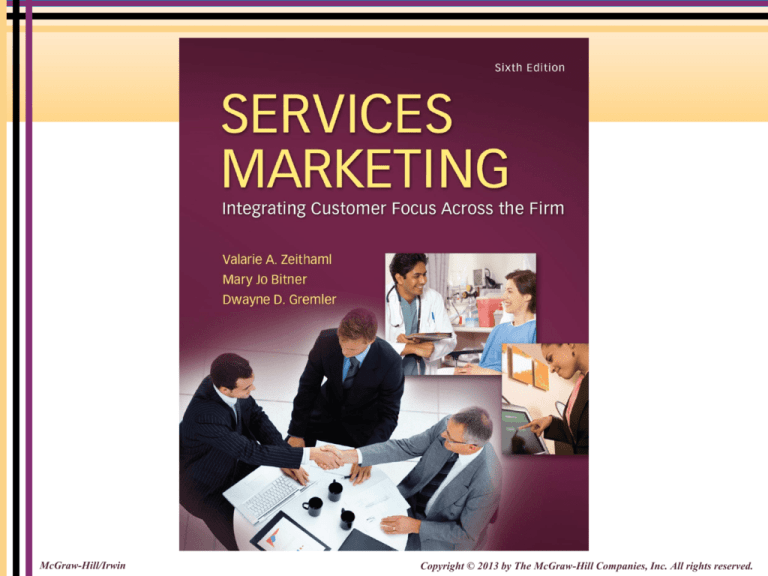
McGraw-Hill/Irwin
Copyright © 2013 by The McGraw-Hill Companies, Inc. All rights reserved.
A Note on the
PowerPoint Slides...
These PowerPoint slides contain selected exhibits,
figures, and tables from the chapters as well as
objectives for the chapters. For some chapters, we
include extra lecture slides and in-class exercises that
we have compiled and used in our classes. The lecture
slides are not intended to provide full outlines or
complete lectures for the chapters, but rather may be
used selectively to enhance class sessions.
1-2
Part 1
FOUNDATIONS
FOR SERVICES
MARKETING
1-3
Chapter
Introduction to Services
1
What are Services?
Why Service Marketing?
Service and Technology
Characteristics of Services
Service Marketing Mix
Staying Focused on the Customer
1-4
Objectives for Chapter 1:
Introduction to Services
Explain what services are and identify important trends in services.
Explain the need for special service marketing concepts and practices and
why the need has developed and is accelerating.
Explore the profound impact of technology on service.
Outline the basic differences between goods and services and the
resulting challenges and opportunities for service businesses.
Introduce the expanded marketing mix for services and the philosophy of
customer focus as powerful frameworks and themes that are
fundamental to the rest of the text.
1-5
Examples of Service Industries
Health Care
hospital, medical practice, dentistry, eye care
Professional Services
accounting, legal, architectural
Financial Services
banking, investment advising, insurance
Hospitality
restaurant, hotel/motel, bed & breakfast
ski resort, rafting
Travel
airline, travel agency, theme park
Others
hair styling, pest control, plumbing, lawn maintenance, counseling services, health
club, interior design
1-6
Contributions of Service Industries to
U.S. Gross Domestic Product
1-7
Tangibility Spectrum
1-8
Why Service Marketing?
Services dominate U.S. and worldwide
economies
Service as a business imperative in goodsfocused businesses
Deregulated industries and professional service
needs
Service marketing is different
Service leads to profits
1-9
Percent of U.S. Labor Force by Industry
1-10
Percent of U.S. Gross Domestic
Product by Industry
1-11
Examples of Goods Companies that are
Expanding into Services
Boeing
1-12
Eight Central Paradoxes of Technological
Products
1-13
Characteristics of Services
Compared to Goods
Intangibility
Simultaneous
Production
and
Consumption
Heterogeneity
Perishability
1-14
Comparing Goods and Services
1-15
Implications of Intangibility
Services cannot be inventoried
Services cannot be easily patented
Services cannot be readily displayed or
communicated
Pricing is difficult
1-16
Implications of Heterogeneity
Service delivery and customer satisfaction
depend on employee and customer actions
Service quality depends on many uncontrollable
factors
There is no sure knowledge that the service
delivered matches what was planned and
promoted
1-17
Implications of Simultaneous Production
and Consumption
Customers participate in and affect the
transaction
Customers affect each other
Employees affect the service outcome
Decentralization may be essential
Mass production is difficult
1-18
Implications of Perishability
It is difficult to synchronize supply and demand
with services
Services cannot be returned or resold
1-19
Search, Experience, and Credence Qualities
1-20
Challenges and Questions for Service
Marketers
Defining and improving quality
Designing and testing new services
Communicating and maintaining a consistent image
Accommodating fluctuating demand
Motivating and sustaining employee commitment
Setting prices
Organizing to facilitate strategic and tactical decision-making
Finding a balance between standardization and personalization
Protecting new service concepts from competitors
Communicating quality and value to customers
Ensuring the delivery of consistent quality service
1-21
Traditional Marketing Mix
Elements an organization controls that can be
used to satisfy or communicate with customers:
Product
Price
Place
Promotion
1-22
Expanded Mix for Services – The 7 Ps
Product
Price
Place
Promotion
People
All human actors who play a part in service delivery and thus influence the buyer’s
perceptions: namely, the firm’s personnel, the customer, and other customers in
the service environment.
Physical Evidence
The environment in which the service is delivered and where the firm and
customer interact, and any tangible components that facilitate performance or
communication of the service.
Process
The actual procedures, mechanisms, and flow of activities by which the service is
delivered—the service delivery and operating systems.
1-23
Expanded Marketing Mix for Services
1-24
Ways to Use the 7 Ps
Overall Strategic
Assessment
How effective is a firm’s
service marketing mix?
Is the mix well-aligned with
overall vision and strategy?
What are the strengths
and weaknesses in terms
of the 7 Ps?
Specific Service
Implementation
Who is the customer?
What is the service?
How effectively does the
service marketing mix for a
service communicate its
benefits and quality?
What changes/
improvements are needed?
1-25

